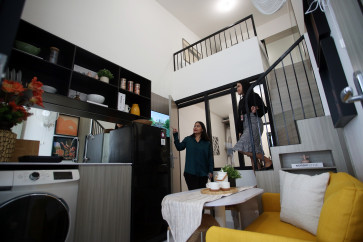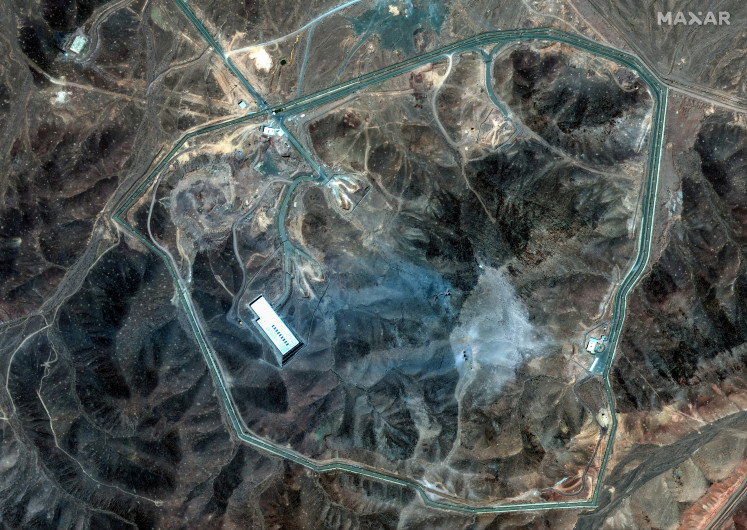Popular Reads
Top Results
Can't find what you're looking for?
View all search resultsPopular Reads
Top Results
Can't find what you're looking for?
View all search resultsSidemen traditional fabric aims to go global
Unfinished product: A weaver at Sidemen village, Karangasem, one of the regencies in the Eastern part of Bali, applies her skills to making what will become a smooth and colorful woven cloth with various motifs
Change text size
Gift Premium Articles
to Anyone

U
span class="caption" style="width: 398px;">Unfinished product: A weaver at Sidemen village, Karangasem, one of the regencies in the Eastern part of Bali, applies her skills to making what will become a smooth and colorful woven cloth with various motifs. JP/Desy Nurhayati
Tucked away in Sidemen village, Karangasem, one of the regencies in the Eastern part of Bali, I Gusti Ayu Oka Swastika’s shop remains a treasure chest of smooth and colorful woven clothes with various motifs.
Some of them are made of silk, while others are made of cotton and rayon, but all kinds boast beautiful designs that reflect the characteristics of the village.
“This woven cloth is unique to Sidemen,” said Swastika, a native from Sidemen who has been running a woven cloth business for the last 15 years under the brand name Kidang Kencana.
Swastika created all the motives, inspired by her ancestors.
Villagers tend to use the woven cloths when they attend special occasions, especially religious and traditional ceremonies.
A piece of the hand-made woven cloth costs between Rp 200,000 (US$21) and Rp 8 million, depending on the kind of fabric and the complexity of the motifs.
The silk woven cloth is the priciest, ranging from around Rp 2.5 million to Rp 8 million, while the cotton- and rayon-made are cheaper, usually around Rp 200,000, Rp 450,000 and Rp 600,000
a piece.
It costs between Rp 1.5 million and Rp 2 million to create a piece of the traditional cloth.
Customers are not only able to pick the available designs of the woven cloth, but they can also customize their own motifs.
“We receive orders from customers who want special or customized designs. We will make the motif no matter how complex it is,” Swastika said.
In her shop, Swastika also has a large room where weavers can be seen working on their pieces of cloth. She employs 50 weavers, who are mostly natives of Sidemen village.
With more than 10 weaving machines, her small enterprise can produce around 10 pieces of cloth per month.
“We usually finish one piece within three to four months,” said one of the weavers, Wija, while showing a 2-meters long and 50-meters wide silk piece she was working on.
“We need to be very attentive to detail and careful to create a perfect piece,” said I Gusti Ayu Oka Ladri, who was making her first piece since she has only been working there for three months.
Each weaver earns around Rp 500,000 per piece.
Since most of the weavers have weaving machines at home, they are also allowed to take “work” home.
Swastika said that the number of clothes she could sell every month varied.
“Sometimes I only sell five, but in other months I will sell more than 10.”
Most of her customers are usually tourists, both domestic and foreign.
The woven clothes have been marketed to some areas nationwide, including to Jakarta, Yogyakarta, Surabaya and Lombok.
Although the traditional clothes have only reached the domestic market, Swastika hopes her products will one day tap into the international market.
“I regularly join various exhibitions in Jakarta, Denpasar and other capitals to reach wider markets.”
She said one of the challenges she encountered while running a small enterprise of woven cloth was the need to continuously innovate creating new designs to attract more customers.
“We never stop creating more complicated motives. The more complicated, the more expensive,” she said.
The Sidemen woven cloth was exhibited in this year’s “Bali Nusra Tangi 2009” event at the ballroom of Discovery Kartika Plaza Hotel in Kuta.
The event, organized by the Culture and Tourism Ministry and the Udayana Military Commander, included a fashion show of traditional attires from Bali, West Nusa Tenggara and East Nusa Tenggara.









